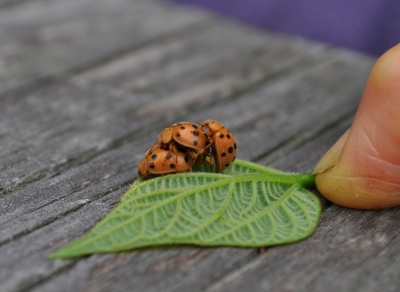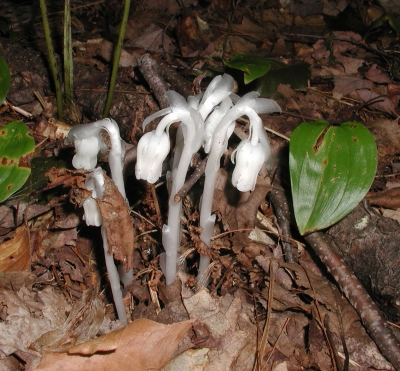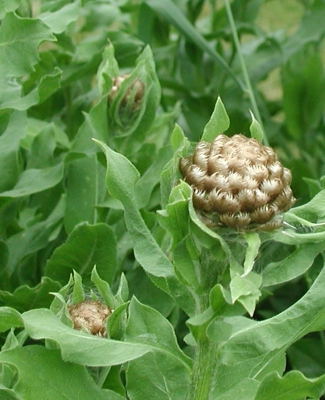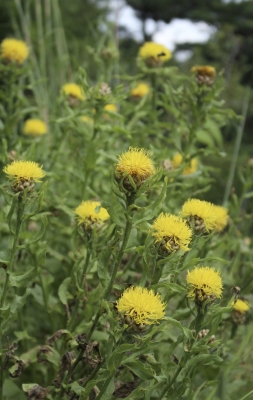GOOD FUNGI AND BAD INSECTS
/8 Comments/in Gardening, Pests, Soil, Vegetables/by Lee ReichFungi I Like and Bean & Japanese Beetles (Don’t Like)
Where once scorned or appreciated only after being sautéed in butter, fungi have finally come into their own. If you’re among those who isn’t awed by fungi except when they’re sautéed, swallow this: each gram of soil (the weight of a paper clip) might house over a million fungi, or anywhere from 10 to 100 pounds of them in the top 6 inches of a 1000 square feet of soil. And most of what they do — for plants and soil, forget about your taste buds for now — is beneficial.
I recently heard of a project using fungi as a building material. On exhibit at the Metropolitan Museum of Art’s PS1 in New York City is Hy-Fi, a cylindrical tower built our of bricks made from fungi that have been fed cornstalks, the fungi’s fine, thread-like hyphae growing to create dense bricks. An organically grown building! Among the benefits touted were that a building made of fungi could be recycled.
I’m not so sure that a building that can be recycled is a good thing, but one statement by the architect did raise my hackles: that the building could be made of waste materials, such as cornstalks. The same argument could be or has been used for ethanol production, which could be made from the same waste material.
Corn stalks might be waste material in the sense that we don’t eat them, perhaps not even always feed them to animals. But corn stalks, wheat straw, and other so-called “waste materials,” as the architect perhaps inadvertently pointed out, are a gourmet delight for fungi. Also good food for bacteria (3 million to 500 million per gram of soil), actinomycetes (1 million to 20 million per gram of soil), as well as protozoa, nematodes, and other soil creatures. And don’t forget about earthworms (2 to 22 pounds per 1000 square feet of ground). There’s a lot of hungry creatures down there.
So these materials are not waste; they are food for soil life. They are what put the “organic” in organic gardening and farming. (They are “organic” in the sense that they were once living, and that they contain carbon compounds, mostly combined with hydrogen and oxygen.) They confer a range of physical, nutritional, and biological benefits to soil, plants, and, hence the animals, including humans, that feed on them. Depriving the soil of these organic materials is what led, in part, to the dust bowls of the 1930s.
Corn stalks as well as other organic materials too often considered as waste should be returned to the soil, either directly or after being first run through a compost pile. One measure of soil quality is the amount of organic material it contains.
Waiting Out Japanese Beetles
Japanese beetles have not come into their own; they have never been and continue to NOT be appreciated. The swarmed in a few weeks ago to make lace of the foliage of a whole host of plants. Grapes are among their favorites, evident by merely looking out on the landscape and picking out the hole-y grape leaves. (The leaf veins typically remain intact.) Although roses are also a reputed favorite, the beetles left mine unscathed.
Most interesting is the beetle’s effect on my hardy kiwifruits, specifically the super-hardy sorts (Actinidia kolomikta). I have four plants, 3 females — Krupnoplodnaya, Aromatanya, and Sentayabraskaya — and one male. Of all those plants, only the Sentayabraskaya plant was attractive to the Japanese beetles, dramatically so. Looking up, I can see sky through almost every leaf.
Japanese beetles are hard to keep in check. For a few plants, hand picking into a can of soapy water (the soap so they don’t just fly out after a quick bath) is effective. The biological insecticide milky spore disease, applied to lawns to kill the grub stage in the soil, is sometimes effective, especially in more southerly locations. Of course, beetles emerging from the soil in summer can fly, so milky spore is useless unless done on a neighborhood scale. Neem is a relatively benign repellant and insecticide that’s somewhat effective sometimes; it would require too much spraying, especially for something with such an iffy effect.
So I just wait the beetles out. Plants can tolerate a certain amount of damage and the beetles typically wave goodbye to go burrow into the soil and lay eggs sometime in August. The wait was especially short this year, with most of the beetles departing by the third week in July. Thank you guys, and gals.
And Where Did Mexican Bean Beetles Go?

A Mexican bean beetle threesome
Other pests also come and go. Mexican bean beetles, mentioned last week, still are keeping to themselves, wherever that might be but not in my garden. Tomato hornworms, which are large caterpillars with voracious
appetites, stripping leaves from tomato plants in the matter of hours, turned up in a friend’s garden. Fortunately, piggybacking those beetles were what looked like grains of rice. They’re actually cocoons of a braconid wasp, which will kill the hornworm. Leaving parasitized beetles alone lets the parasite live to attack more hornworms.
Also worth ignoring are the pimples that have been appearing on leaves of many pin oaks. Those pimples — hemispheres about 1/2” across — are galls. Plant galls are abnormal growth made in response to an irritant such as a bacteria, a fungus, or, most commonly, an insect. A few galls here and there rarely do a plant harm.
 Those oak leaf galls are pocking almost all the leaves on my pin oak. Still, I’ll ignore them or admire them; they sort of liven up the look of the tree. It’s too late, anyway, to do anything about them.
Those oak leaf galls are pocking almost all the leaves on my pin oak. Still, I’ll ignore them or admire them; they sort of liven up the look of the tree. It’s too late, anyway, to do anything about them.
WEEDS, BIRDS, & PEST-FREE CURRANTS
/0 Comments/in Fruit, Gardening, Pests/by Lee Reich
I Battle Weeds and Birds, but Currants are Care-free
Part of my weedless gardening technique (which I thoroughly fleshed out in my book Weedless Gardening) involves — sad to say, for some people — weeding. After all, no garden can ever be truly weedless. Even people who spray Roundup eventually get weeds as they inadvertently “breed” for Roundup-resistant weeds, which now exist. My techniques are weed-less rather than weedless.
Which brings me to hoeing. Most years my hoe rests on its designated hook in the garage. This year, it’s hardly made it back to garage, mostly just leaning up against the garden fence alongside the gate. “And why is this?” you might ask. The answer is rain. This season, rainfall has been dropping in sufficient amounts at regular intervals, all of which has coaxed good plant growth, including that of weeds.
More importantly, the rainfall has promoted plant growth in paths and between widely spaced plants. One leg of my 4-legged “weedless gardening” stool calls for drip irrigation, which pinpoints water near plants. In a normal year, or a dry year, there’s little moisture to spur on weed growth elsewhere. This year, rainfall has democratically spurred weed growth everywhere.
Hence the hoe. The best hoes to snuff out young weeds without unduly disturbing the ground are ones with thin, sharp blades that lie parallel to the ground. All that’s needed is to slide such hoes back and forth a quarter of an inch or so beneath the surface, cutting the stems of hopeful, young interlopers. The work, if can be called that, is quick and easy, not calling for the “iron back with a hinge in it” recommended for a gardener by Charles Dudley Warner in his 19th century classic My Summer in the Garden. Too many people use a pull or draw hoe, whose blade lies perpendicular to the handle, to try to conquer weeds.
The hoes I’m recommending are so-called push or thrust hoes. Some examples include the collinear hoe, the scuffle hoe, the stirrup hoe, and, my favorite, the wingèd weeder. With any of these hoes, roots aren’t damaged and lower depths of soil remain at lower depths so that inevitable weeds seeds buried there are not awakened as they are exposed to light. (Minimal soil disturbance is another leg of my 4-legged “weedless gardening” stool.)
Still, my wingèd weeder is not effective unless it is used — frequently this season, ideally once a week or within a couple of days after a rain. Used in a timely manner, the wingèd weeder does a quick, effective, and satisfying job.
Currants are an Old-Fashioned Fruit Easy to Grow
“The currant takes the same place among fruits that the mule occupies among draught animals—being modest in its demands as to feed, shelter, and care, yet doing good service,” wrote a nineteenth-century horticulturalist. Hoeing takes time, especially this year, so it’s nice to balance that with something — currants, in this case — that is “modest in its demands.”
One of my currant bushes, a Perfection (that’s the variety name) red currant, splays its stems upward and outward in an ornamental bed in front of my house. Sharing that bed, for beauty and for good eating, are huckleberries, lowbush blueberries, and lingonberries, and, for beauty alone, mountain laurels and dwarf rhododendrons.
 The only care my currant gets is, anytime from November until late March, pruning. The plant bears best on 2- and 3-year-old stems so I cut away anything older than 3 years old and reduce the number of new, 1-year-old stems to the half dozen or so most vigorous ones. The whole bed gets a sprinkling of either soybean meal (1# per hundred square feet) or alfalfa meal (3# per hundred square feet) in late fall, topped with a mulch of leaves or wood chips.
The only care my currant gets is, anytime from November until late March, pruning. The plant bears best on 2- and 3-year-old stems so I cut away anything older than 3 years old and reduce the number of new, 1-year-old stems to the half dozen or so most vigorous ones. The whole bed gets a sprinkling of either soybean meal (1# per hundred square feet) or alfalfa meal (3# per hundred square feet) in late fall, topped with a mulch of leaves or wood chips.
The bush began bearing towards the end of June and a few clusters of the plump, jewel-like fruits still hang from the branches. Most people use red currant for jelly or sauce. I like to eat them straight up, with my morning cereal, for instance. The flavor is tart early on but has mellowed by now.
Currants were once a more popular fruit in America, and especially here in the Hudson Valley. They are one of the few fruits that tolerate shade (and deer!), and were often grown in the shade of large, old apple trees. Local folk, including children, would ride out to the orchards in hay wagons for communal picking.
Currant is, truly, among the uncommon fruits for every garden (good book title, that).
I Reluctantly Share Some Blueberries with Birds
Just a quick note about my blueberries, which are also relatively carefree. Last year’s abundance of cicadas may have upped bird populations, or at least made birds believe that lots of food would always be in the offing. Not so, birds. Perhaps, then, that’s why so many bird are fluttering all around my blueberries, mostly on the outside of the net that encloses my Blueberry Temple of 16 plants.
Right now a hawk — a cardboard one, swooping in breezes as it hangs from a string fixed to the end of an long, inclined bamboo pole — is meant to dissuade birds from even approaching the net. Calm mornings keep the hawk still enough so an occasional bird find their way through the net (where?) to venture into the Temple.
Eerie White to Golden Flowers, with Some Fungi Helping Out
/3 Comments/in Design, Gardening, Soil/by Lee ReichWhite Indian pipes, mycorrhizae, and a golden flower
I do occasionally tear myself away from the farmden. So into the woods I went last Friday and as I was hiking along and glancing down at the trail, I came upon one of my favorite flowers. It’s a favorite not for its beauty but for what it hints at of goings-on beneath the soil surface.
The flower was indian pipes, Monotropa uniflora, an eerily white plant that looks like a upright tobacco pipe whose stem has been poked into the ground. Yes, it’s white. All white. You might rightly wonder how the plant synthesizes carbohydrates for energy and for structure. Photosynthesis, which makes carbohydrates, requires chlorophyll, which is green. Indian pipes don’t need chlorophyll because they get their carbohydrates from neighboring trees.
Join me while I go below ground. Stopping for a look at the roots of indian pipes, we see that they are infected with the fine threads of fungal hyphae. Now, if we follow the fine threads of the fungal hyphae out of the roots and through the soil, we eventually come to the roots of a nearby tree whose roots also are infected by one and the same fungus. A continuous connection exists from the tree to the fungus to the indian pipes.
The tree does have green leaves and, as with other plants, some of the products of its photosynthetic labors are channeled down to its its roots. Some of those products travel out the roots and into the fungal hyphae, and some of that is drawn out of the hyphae into the indian pipes for the latter’s sustenance and growth. Sounds like a one-sided relationship, a pretty good deal for the indian pipes. It is. The plant is a parasite, taking but offering nothing in return.
The relationship between the fungus and the tree, however, is symbiotic and called mycorrhizae (my-co-RYE-zay, which means fungus-root). Yes, the fungus sucks up some of the tree’s photosynthates, but in return it sucks up nutrients from the soil, then channels them back to the tree’s roots. The network of fungal hyphae in the soil is much more extensive than that of the roots, so, with fungal hyphae as “extenders,” the effective volume of soil “grazed” by roots is increased. Mycorrhizae are especially important for uptake of nutrients such as phosphorus, which roots (or their fungal extenders) must go out and find because it moves but little in the soil.
Myco . . . say what?
Wouldn’t mycorrhizae spur growth of garden plants? Yes. But look out your window; most of the plants you see are naturally mycorrhizal already. Still, deliberate inoculation might benefit young transplants. You can purchase inoculum, but the problem is that purchased inoculum often is not of fungal species best adapted to a particular location.
A better approach would be to keep your indigenous fungi happy. Limit tillage, which discombobulates the hyphae, grow a variety of plants, especially those that form mycorrhizal associations, and avoid pesticides. Also limit phosphorus fertilizers because they suppress mycorrhizae.
Another approach would be to grow your own mycorrhizal inoculant of local fungal species. Basically, you mix up a big batch of potting soil that has some indigenous soil in it and is not too high in nutrients. In this potting soil you grow a suitable host plant. (Not spinach, beets, or any plant in the cabbage family, none of which ever form mycorrhizae.) After the host plant dies at the end of the season, what’s left in the pot is indigenous fungal inoculum that can be added to a potting soil for growing seedlings. For more details, see http://rodaleinstitute.org/a-complete-how-to-on-farm-am-fungus-inoculum-production/. I use garden soil and compost in my potting mixes and assume there’s sufficient inoculum already present.
Grow Some Gold
As I rounded the bend at the back of my garden after my woodland hike, I came face to face with a flower I had planted temporarily back there, giant knapweed (Centaurea macrocephala), also known as Armenian basket flower, globe centaurea, and yellow hardhat. Plants with too many common names are usually suspect to me, and none of this plant’s names have a particularly nice ring to them — yet this plant is a showstopper.
From the whorl of rather coarse leaves at the base of the plant rises a sturdy flower stalk. At almost 4 feet high, a big fat bud forms atop the stalk, a bud that looks like a globe artichoke that has been gilded. Nice enough even then, but a couple of weeks later — which is now — a bottlebrush of lemon yellow petals spills forth from the top of the bud.
Globe centaurea, the name most euphonious to my ears, tolerates heat and cold (USDA Hardiness Zones 3 to 8), and is relatively carefree. No need to prop the flower stalk up with a stake. The blossoms put on their show for about a month, not counting the gilded opening act, and hold up well as cut flowers, or can be dried.
 Globe centaurea deserves more attention over much of the country, except perhaps in the Pacific Northwest, where it’s considered invasive. I grew it years ago, and it disappeared. Nice to have it back.
Globe centaurea deserves more attention over much of the country, except perhaps in the Pacific Northwest, where it’s considered invasive. I grew it years ago, and it disappeared. Nice to have it back.




